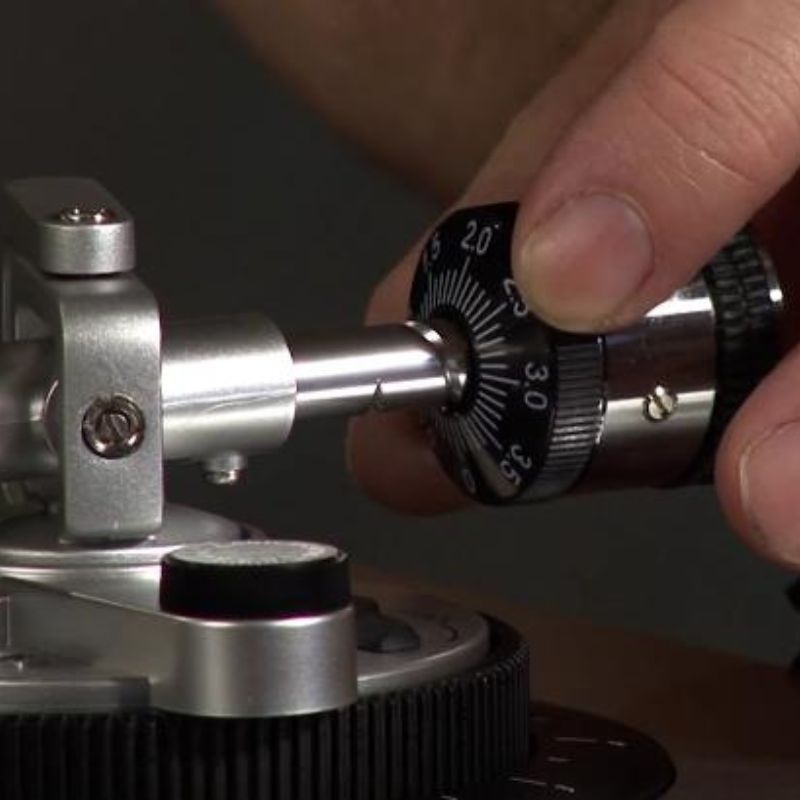A common term you'll come across in the turntable world is "Anti-Skate".
You're probably wondering what anti-skate is, why you need it and how to set it up?
In short, anti-skate is designed to counteract the force that pulls the tonearm into the centre of your record. It keeps the needle on-track (literally) to ensure your record plays without skipping.
Read on to learn more about how it works and how you adjust it.
Understanding The Basics: What Is Anti-Skate?
Before we dive into the deep end, let's get our feet wet with the basics.
The term 'anti-skate' might sound like something out of a sci-fi movie, but it's actually a crucial part of your turntable setup.
In the simplest terms, anti-skate is a mechanism that helps balance the stylus (the needle) as it traverses the grooves of your beloved vinyl records.
Now, you might be wondering why this balance is so important.
Well, imagine you're ice-skating. If you lean too much to one side, you'll end up spinning in circles or, worse, falling flat on your face.
Similarly, if the stylus leans too much towards one side of the groove, it can cause distortion, skipping, or even damage to your records.
Not a pretty picture, is it?
The Physics Behind Anti-Skate
So, how does anti-skate work?
It all boils down to physics.
When the stylus moves along the record's groove, it experiences a force known as 'skating force'. This force tends to pull the stylus towards the centre of the record.
The anti-skate mechanism counteracts this force, keeping the stylus centred in the groove.
The exact amount of anti-skate force needed can vary depending on several factors, including the stylus pressure and the record's groove velocity.
This is why most turntables allow you to adjust the anti-skate setting. It's all about finding the perfect balance!
Setting Up Anti-Skate: A Step-By-Step Guide
Now that we've got the theory down, let's roll up our sleeves and get practical.
Setting up the anti-skate on your turntable might seem daunting, but it's actually quite straightforward.
Here's a step-by-step guide to help you out.

Step 1: Locate the Anti-Skate Control
The first step is to locate the anti-skate control on your turntable.
This is usually a small dial or slider located near the base of the tonearm. It might be labelled 'anti-skate', 'bias', or something similar.
If you can't find it, don't panic!
Not all turntables have an adjustable anti-skate control.
Some have a fixed setting, while others use a different mechanism altogether.
When in doubt, consult your turntable's manual or contact the manufacturer.

Step 2: Set the Stylus Pressure
Before you adjust the anti-skate, you'll need to set the stylus pressure.
This is usually done by adjusting the counterweight at the back of the tonearm.
Again, the exact method can vary, so check your manual if you're unsure.
Once the stylus pressure is set, you can move on to the anti-skate.
As a general rule of thumb, the anti-skate setting should be roughly equal to the stylus pressure.
So, if your stylus pressure is 2 grams, start with an anti-skate setting of 2.
Step 3: Fine-Tune the Anti-Skate
Now comes the fun part: fine-tuning the anti-skate.
This is where you'll need to use your ears.
Play a record and listen carefully. If you hear distortion or skipping, adjust the anti-skate setting until the sound improves.
Remember, every record and stylus is unique, so don't be afraid to experiment.
What works for one record might not work for another. The key is to trust your ears and have fun with the process!
Conclusion
So there you have it, the lowdown on anti-skate.
It might seem like a small detail, but it plays a crucial role in ensuring that your records sound their best. So next time you're spinning your favourite vinyl, spare a thought for the humble anti-skate. It's the unsung hero of your turntable!
Remember, setting up your turntable is part science, part art.
It's about understanding the mechanics, but also about trusting your instincts and enjoying the journey.
So don't be afraid to experiment and make adjustments. After all, that's part of the fun of vinyl!





